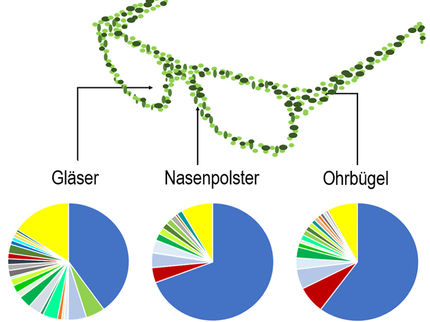Decomposition of textile products in the ground
Laboratory tests help with evaluation of environmental compatibility
Like all organic materials, textiles will decompose under the influence of water and microorganisms in the ground. Under comparable environmental conditions, it depends mainly on the raw materials used whether the Decomposition process takes place over the course of months, years, decades or even centuries. In combination with any added chemical finishes these are also a crucial factor for the decomposition potentially generating individual substances or substance combinations which may be harmful to flora and fauna.
Raw materials (fibre types) and additional finishes are some of the factors the scientists at the Hohenstein Institute take into account when evaluating the effects of textiles on the environment. In addition to textile manufacturers, it is increasingly the producers of prefabricated automotive parts, the chemical industry and recycling companies who obtain advice from the team of Prof Dr Dirk Höfer who will create an individual test plan for the neutral evaluation of the ecological harmlessness of products.
As a rule, the evaluations are based on standardised soil burial tests according to international standards which are used to determine the decomposition or breakdown behaviour of materials. Subsequent ecotoxicological examinations allow the scientists to draw conclusions about the environmental compatibility in the sense of risk monitoring. In contrast to classical analysis methods, this method does not focus on verifying the presence of individual substances with known ecological hazards. It is rather a consideration of influence of the sum of all individual substances and substance combinations on biological systems. The method uses marine bacteria, water fleas and fish eggs, among other things.
Regardless of the field of use of the textile materials, the requirements concerning decomposition in the ground can vary greatly in some cases: For everyday products such as clothing or home furnishings, decomposition e.g. in landfill should take place as quickly as possible and without any residues which could be harmful to health or environment.
The same applies to geotextiles where composition should take place as quickly as possible while generating valuable humus to promote natural growth of plants. In contrast to this, other technical textiles and geotextiles are treated with chemical substances to make them more resistant to microorganisms such as mould. The aim here is to optimise the durability of reinforcements for embankments, dykes etc. where these textiles are used. The Hohenstein experts are studying how to meet the requirements of both objectives. Established methods such as standardised soil burial tests in combination with laboratory tests offer an interesting alternative to extensive outdoor tests in terms of time and cost involved.
Most read news
Topics
Organizations
Other news from the department research and development

Get the analytics and lab tech industry in your inbox
By submitting this form you agree that LUMITOS AG will send you the newsletter(s) selected above by email. Your data will not be passed on to third parties. Your data will be stored and processed in accordance with our data protection regulations. LUMITOS may contact you by email for the purpose of advertising or market and opinion surveys. You can revoke your consent at any time without giving reasons to LUMITOS AG, Ernst-Augustin-Str. 2, 12489 Berlin, Germany or by e-mail at revoke@lumitos.com with effect for the future. In addition, each email contains a link to unsubscribe from the corresponding newsletter.





















































